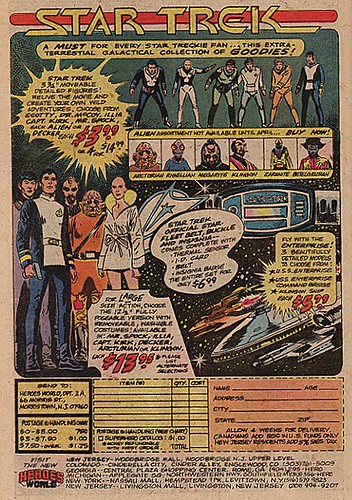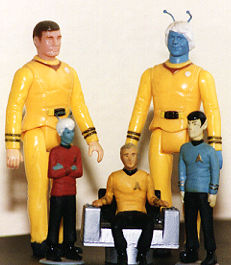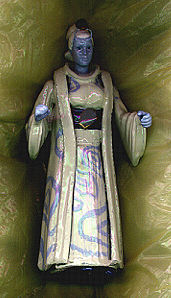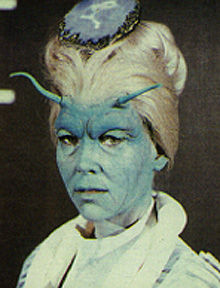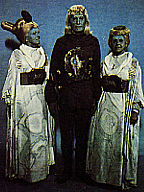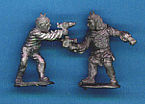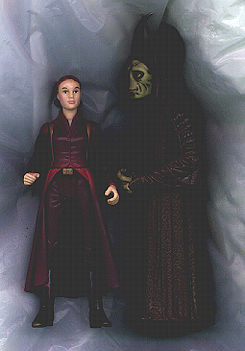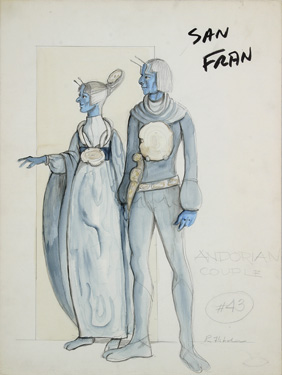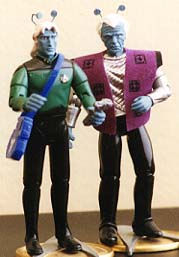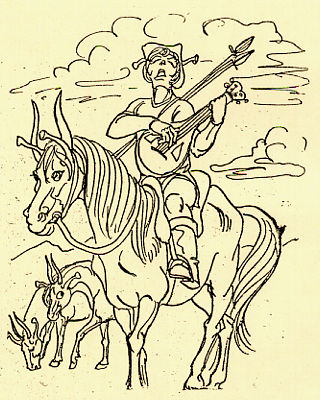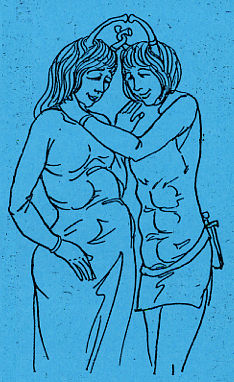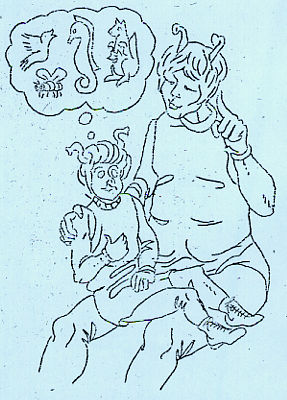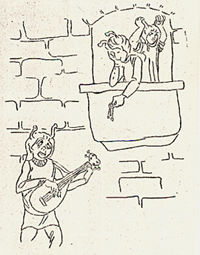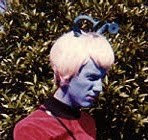edited by Leslie Fish
CONTINUED FROM PART 1
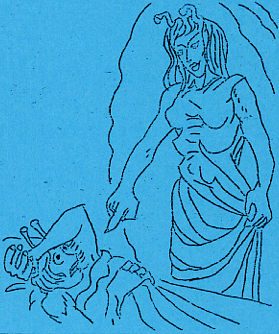
CULTURAL EFFECTS OF THE REPRODUCTORY PROCESS
Because pair-bonding and "true" mating causes such changes in the individual's physiology and lifestyle (and, subsequently, in the personality), it is surrounded by a constellation of important social customs. Bonded couples, being necessarily concerned with feeding their prodigious numbers of offspring, tend to be sedentary and conservative - and concerned also with trade, war or other means of acquiring land and livestock. Neuters, having no fierce biological commitment to other individuals, tend to be nomadic and innovative, concerned more with artistic or abstract studies. Bonded couples also dress and speak in different modes than neuters, are more formal in public and have a different role in religious practices. For example, only neuters worship
Hyuhef, Inspirer of Playmates, and only bonded pairs take part in the rites of the fertility-goddess.
These differences, plus the above-mentioned variation in sexual behaviour, are doubtless the causes of the first contact-team's disastrous misassumption that neuters and bonded pairs were two different classes, or races, with neuters socially subordinated to the land-owning bonded pairs. One result of this unfortunate mistake was the discovery that bonded pairs tend to be much fiercer in battle than neuters.
So great are the social and psychological changes brought about by sexual bonding that neuters usually regard the bonded state with mixed fear and fascination. A common feature of Andorian psychology is the bonding dream, usually described as a nightmare, in which a neuter dreams of the expected change in terms of a supernatural visitant whose touch transforms the dreamer in mind and body. The dreamer usually wakens in a state of mixed fright and extreme sexual arousal, and often counteracts this by plunging into fierce sexual activity or personal combat. Consequently, the standard colloquialism applied to a neuter observed in an agitated or belligerent state is "S/he must have dreamed of
The Changer". Another result is that
The Changer is an important deity in the Andorian pantheon, called
The First Child of the Great Mother, whose presence is invoked by lovers who wish to marry. Thus do dreams become gods.
Some neuters, for career, personal or religious reasons (such as sworn service to
Armoured Hlasha, Protector of Mercenaries), choose to remain neuters all their lives, never experience the Change and, hence, never breed. This is considered the honourable form of birth control and older neuters are highly respected for their dedication and self-discipline. Less honourable means of birth control include egg-smashing and infanticide.
Andorians who do marry promptly find themselves faced with the great physiosocial problem of hyper-fertility. Litters of young usually number from four to six. Litters of eight are not rare. Since a bonded couple can carry three litters at once (one in the female's womb, one in the male's womb and one in the pouch) while nursing a fourth, a healthy couple can produce up to 24 children per standard year - and an Andorian's breeding life can extend for 40 years or more. One of the common epithets for the fertility goddess is
Mother of 1000 Young - which may not be an exaggeration. Andorians themselves speculate that the concept of the fertility-goddess began with a famous ancestress who spawned great numbers of surviving children, passed in due course from a heroic ancestor-spirit into a tribal goddess, and later merged with similarly evolved goddesses of other tribes. Thus do memories become gods.

SOCIAL EFFECTS OF ANDORIAN FERTILITY
The first effect of the hyper-efficient reproductive system is the clan-centred structure of Andorian society. A single couple can produce a sizable clan in short order; indeed, if a couple begins breeding early, it can expect to preside over four generations of descendants - usually living on the same lands and guarding the same herds. Raising such numbers of offspring absorbs most of a bonded couple's time and attention, leaving little energy for contact with members of other clans. Children raised in these clans have so many relatives of various ages to interact with that they rarely seek contact outside the clan. In view of this, it is not difficult to see why the clan is the only stable Andorian social unit.
The second effect of Andorian hyper-fertility is an aggressive and territorial nature. In order to feed all those children, even a single couple must strive constantly to increase its herds - which necessarily means increasing the tribal lands, since Andorian vegetation is notoriously unsuitable to cultivation and the herds must perforce go wherever the fat-grass chooses to grow. Such expansion inevitably brings a clan into competition with its neighbouring clans, and the usual result is war. Although occasionally one finds a clan that has, by virtue of unusual cunning or strength or luck, managed to overcome its neighbours and absorb their lands, herds and survivors, it is far more common for such clan warfare to result in no significant change of borders, but merely a paring down of numbers on both sides. This is the origin of the Vulcan "joke" about "Andorian population control".
This constant outward direction of aggression makes Andorians correspondingly peaceful within the clan - but only up to a point. The constant population pressure can operate against familial harmony at the drop of a sword. Clans at peace with their neighbours often turn their aggression inward, resulting in dynastic struggles and fratricide, which usually does not end until the clan is decimated by warfare - or until war with neighbouring clans is resumed. On Andor, the phrase: "The family that slays together, stays together" is not a joke.
Fratricidal competitiveness is not dependent solely on territoriality; it begins with sibling rivalry among littermates, which is fierce enough by nature and unfortunately exacerbated by culture. The competition begins, literally, in the hour of birth. Shortly after jettisoning the pouch-fangs, the young emerge from the pouch and scramble for the mother's breasts - which, unfortunately, are not all alike.
To free the mother's hands for self defence and feeding, the breasts of a fertile female Andorian are covered with curly white fur to which the infants cling. The upper two breasts, being the largest and having the most fur (therefore called
white teats), are the most desirable from the infant's point of view. The second pair is smaller, less heavily furred (thus
grey), and less desirable. The lowest pair is least furred (
blue) and considered suitable for the runts of the litter. Thus, in competing for the best breasts, the children become stereotyped in classifications that last throughout childhood, if not throughout life.
White teat children tend to have superiority complexes and usually stay home to manage the clan herds and lands.
Grey teats tend to suffer from indecision and identity crises.
Blue teats often develop deep resentments and inferiority complexes and tend to have the least loyalty to the clan.
The unfortunate result of this situation is the amazingly fierce Andorian sibling rivalry. One's older or younger siblings may become one's friends, but never one's littermates. Intra-litter fratricide is common and is usually treated as nothing worse than. a serious misdemeanour, comparable to shoplifting.
The more fortunate result of such intra-litter competitiveness is the tendency of lower-ranking littermates to leave the tribe upon reaching first puberty to seek their fortunes elsewhere. The wandering neuter, travelling from clan to clan, thus becomes not only an important factor in randomising the gene pool, but a valuable transmitter of culture as well. Often the wandering neuters are the only source of inter-clan communications; as such, they are highly valued as messengers, teachers, sources of news and bearers of innovations. The most common trade of a wandering neuter in post-industrial times, however, is that of hired herdsman/soldier. Andorian herding clans, being usually involved in wars, are constantly in need of temporary manpower for guarding their lands and raiding their neighbours', and find it more practical to hire soldiers at need than to breed them. As a result, one of the common words for an individual in the neuter phase is derived from
mercenary soldier.
Wandering neuters who survive livestock raids and prove themselves too valuable to be discharged in peacetime often marry into their employers' families. Besides keeping the gene pool refreshed, this system allows for social mobility - thus creating legend after legend of the poor family's poorest child who ends by marrying into a wealthy family and founding a famous dynasty. These factors clarify the famous - and formerly inexplicable - Andorian classic,
'The Love Song of Dyathalih':
"Oh love, of all thy clan the fairest, hear:
I, poor blue-teat pramha-farmer, sing thee my humble song.
Long have I watched thee afar, loving thy glory. Oh love,
Let us not be mercenaries long!
Yea, from the hour thy pouch-fangs dropped,
Thou climbist the high breast to clutch the palest fur,
Kicking thy rivals back. Yea, all thy clan
Knew how destined for great things you were!
Oh play with me, and Change with me,
And let us join our loves;
Our children shall slaughter our noisesome neighbours,
And rule the world in droves."
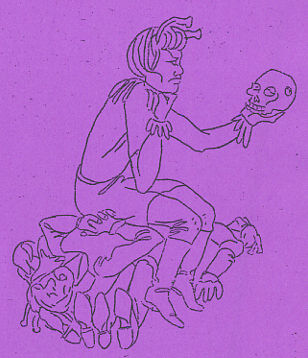
CULTURAL EFFECTS OF THE CLAN-CENTRED SOCIAL STRUCTURE
Because the economy is the chief activity of the clan, religion, art and education are shaped by their relevance to clan economics. Education, particularly on technological subjects, takes precedence over art - which in turn takes precedence over religion. Wandering neuters tend to transmit information on these subjects in the same order of importance, with the result that technological change spreads quickly, artistic innovation more slowly - and religious development progresses hardly at all. Thus, Andorian culture presents the spectacle of a space-age technology, a medieval level of artistic development and a religious mode usually associated with the Late Stone Age.
Andorian science began, understandably, with advances in animal husbandry, ecology, veterinary medicine, defensive architecture, military engineering, and weapons technology. Such advances gave their discoverers advantages over their neighbours and thus spread rapidly, by conquest or transmission by wandering neuters, throughout the society. This insured evolutionary direction toward greater intelligence, higher creativity and further technological progress. Any clan that could produce a creative genius was practically guaranteed a fine and well-fed future.
Unfortunately, the cultural pressure toward purely practical rather than theoretical science has tended to constrain the direction of progress in a few areas. One example of this is the surprising absence of an Andorian-developed faster-than-light space drive. Lacking the necessary backing of purely theoretical mathematics and physics, the Andorians never discovered the principles of FTL drive - which is why they didn't colonise the galaxy long ago, although they have had space travel longer than any other species in the Federation.
The Andorians managed to colonise all twelve planets in their home system, but found the time factor of sub-lightspeed journeys an insurmountable barrier to interstellar colonisation. They did attempt interstellar journeys with sleeper ships and generation ships, but found that sleeper ships fell easy prey to random accidents and that generation ships had a lamentable tendency to break up in civil wars.
The Andorian word for art derives from the ancient words for
family amusement and
ancestor glorification and it is not surprising that Andorian arts are somewhat limited in scope. The plastic arts are primarily decorative (including tapestried blankets and hangings, colorful pottery, intricate jewellery and embellished weapons and utensils), or functional (such as religious idols and icons, commemorative statues, family portraits and educational illustrations of clan histories).
Literature is limited to historical drama (popular mainly in urban areas), literary poetry (written and read primarily by wandering neuters) and song (usually folk ballads meant for the edification and amusement of clan gatherings). Andorian drama bears a strong resemblance to early Elizabethan theatre of Earth in its length, complexity, structure, subject matter, language, and luridness; reviewers often complain that by the fifth act, the players are having difficulty moving about because of the numbers of bodies littering the stage. Literary poetry, although comparatively free and innovative in form, tends to confine its subject matter to mood pieces, usually love songs. Sung poetry is primarily of the sing along ballad variety and its subject matter is generally in the nature of:
"We smote them on the helmet,
And we smote them on the thigh.
We smote them here, we smote them there,
And laughed to watch them die.
Sing: waily, waily, and the gentle rain falls.
We lifted half their livestock,
And their pickled meat and beer,
And we ate and drank and sang about it
For nearly half a year.
Sing: waily, waily, and the gentle rain falls."
Andorian religion is simple, practical and utterly without theological speculation. Andorian "gods" are always deified spirits of heroic ancestors or personifications of natural and psychological forces - or combinations of the two. They have straightforward and practical functions (guiding their descendants, bringing rain, promoting fertility, protecting the herds, etc.), and are seen as having attributes and limitations much like those of their worshippers. For example, the war-god
Fierce Larashkail is usually depicted as armed, embattled, enraged, and pregnant - the epitome of a fierce male Andorian warrior. The limitations of the gods are accepted in the standard nodes of worship, as typified by the
'Prayer of Distress to Barhkoryu of the Rains':
"Oh Soul of Storms, why has thee locked the gates of the sky?
Why has thee turned thy antennae from our distress?
Behold, the fat-grass withereth for thirst.
Our teegh grow hollow-flanked with parched starvation.
Our children perish in outrageous numbers.
What have we done to anger thee to such harshness?
Show us our fault, and we shall correct it gladly.
Surely thou canst not mean to slay us all!
Open the sky, Barhkoryu! Loose the rains!
Then we shall sing thy praises all night long.
We shall feast thy honour and feed thee our best.
Our neuters shall play with what agent thou shalt choose.
Ask and it shall be done, but give us rain!
And if thou provest recalcitrant past enduring,
We shall blow out thy lamps and close thy shrine,
And write insults to thy name on every wall,
And invite thee no more to our, feasts
Until thou shalt relent."
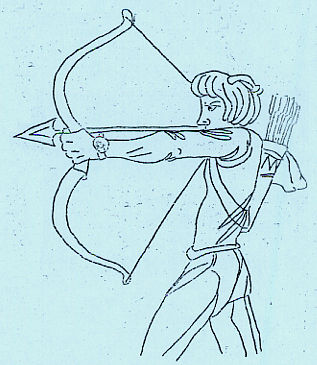
SOCIAL CHECKS ON AGGRESSION
At first glance, one might wonder how such an aggressive species managed to keep from destroying itself when technological progress made super-efficient weaponry possible; it comes as a great surprise that Andor has never suffered what humans would term a major war. The fact is that Andorians place stringent restrictions on their fratricidal weaponry, as well as on their inter-tribal aggression.
Andorians have always restricted their weaponry with their practical attitude toward warfare. Specifically, they never lose sight of what they are fighting for:
hrashklain (food-land). Being painfully aware of their dependency on their herds, and the herds' dependency on the fat-grass, Andorians are much more solicitous of the welfare of their beasts and lands than they are of each other. They are, by nature, the most passionately concerned ecologists in the Federation; not even Vulcans outdo them. The wanton destruction of livestock or grazing-land fills Andorians with horror and outrage; it is the one unforgivable sin, the one crime that can make all neighbouring clans drop their feuds and form solid alliances to destroy the "pervert" who would dare to do such a thing. In fact, the Andorian word for "criminally insane" is derived from the words for
destroyer of grasslands. To an Andorian, the whole point of warfare is to seize the prize which prolongs the life of the victor; therefore, nothing could be more insane than to destroy or injure the prize. As a result, all weapons that could in any way damage the lands or herd are fiercely banned. This is why, despite their warlike nature and long technological history, Andorians still fight their clan-wars with spear and sword, axe and club, and bow and arrow - much to the amazement of all observers.
Another check on inter-tribal warfare is the early invention of trade. Progressive clans soon discovered that by producing desirable goods and exchanging them for livestock, they could increase their herds without losing any children or paying the hire of extra mercenaries. Since the clan structure is well suited to corporate activity, many clans became manufacturing specialists. Clan-houses expanded easily into factories, then factory-towns and thus evolved into the first Andorian cities. A famous example is the Talliryen Clan, whose legendary ancestor, Tallirye, enriched his pramha-poor clan by discovering the smelting of iron. Since the Talliryen family lands sat over a natural deposit of iron ore, the Talliryens soon became iron-workers and iron-mongers for all the surrounding clans. Since their skills made them greatly desirable as allies, as well as too valuable to kill, the Talliryens have not fought a clan war within historical memory. To this day,
Talliryen Steel is one of the most successful clan companies on Andor and Tallirye himself has evolved into the patron god of smithcraft.
The development of non-combative trading clans necessitated the invention of some method of reducing intra-clan friction. One result of this was the evolution of a rigorous etiquette, designed to keep a polite distance between members of the same clan so that they don't get on each other's nerves. The longer a clan is at peace with its neighbours, the more necessary and rigid the etiquette becomes. The above-mentioned Talliryen Clan, for example, with its long history of inter-clan peace, is so fiercely punctilious that it makes medieval Japanese royalty look casual by comparison. This is only slightly less true of other urban clans. In an Andorian city, a social gaffe is cause for assault, murder or ritual suicide - as the original contact team discovered the hard way. This is understandable when one considers that the breaching of custom is the equivalent of declaring war upon members of one's own clan, and hence too dangerous to excuse. Outwardly aggressive, rural Andorians are aware of this urban peculiarity, and find it amusing at best, as
Chondenvre's ballad shows:
"I'd rather fight nine days in ten
And gnaw thin pramha from my neighbour's pen
Than eat fine dinners a la Talliryen.
Thank the gods I'm a country neuter!"
THE EFFECTS OF SPACE TRAVEL AND FEDERATION MEMBERSHIP
With the advent of space travel, Andorians began to think seriously of themselves as a species rather than a collection of clans. The discovery of semi-intelligent life on the fifth planet of their Epsilon Indi system compelled Andorians to consider the existence of other intelligent species and the possibility of interplanetary warfare. This led, by analogy, to the concept of all Andorians as members of one super-clan, faced off against other such super-clans. The immediate result of such thinking was that a planetary government consisting of a council of elders, one from each major clan, became feasible. Thus did Andor jump from a fragmented, clan-based society to a fairly unified, planetary society - without going through the stage of nationalism. This unique case of rapid social evolution proved remarkably successful for the Andorians, although it did cause some problems with early contacts between the Andorian Empire and the other Federation co-founders (Earth, Alpha Centauri, Vulcan, Tellar).
Indeed, one may say that successful relations between Andor and Earth were the result of the famous Andorian practicality. Despite those lamentable early misunderstandings, the Andorians soon realised that membership in a multi-stellar community held great advantages for them - particularly in technological gains, such as reliable methods of birth-control and faster-than-light space drive. FTL drive especially, with its concomitant possibility of interstellar colonisation, may prove to be the greatest scientific advance in Andorian history - freeing the Andorians from their age-old problem of too much population on too little land. This fact alone would explain the presence of so many Andorian neuters flooding Starfleet Academy and, indeed, all Federation space lines, with applications in a desperate attempt to get out into deep space.
Whether or not these escape attempts will be successful in reducing Andorian population pressure, and whether or not such success will reduce the aggressive tendencies of Andorian nature, is still unknown. Nonetheless, there is much reason to hope that, in time, we shall no longer agree with the famous comment by the lone survivor of the first contact team: "Aliens? Migod, what aliens! These people are so alien that, compared to them, the Vulcans might as well be from New Jersey!"
"Even the Mother of 1000 Young, in the end,
Upon the Mother-of-Fat-grass must depend."
Rethon of Clan Trizye, Mercenary.
All text and graphics © 1976, 1997, 2009 Leslie Fish. First published in Sehlat's Roar #2, a fanzine of the 70s, published by Randy Ash. Permission for me to reprint in HTML form granted by the original author/artist and the hardcopy publisher. Thank you Leslie and Randy! Star Trek © CBS Studios Inc. This weblog is not intended to infringe on copyrights held by Paramount/CBS. No text or graphics may be reproduced without permission.





